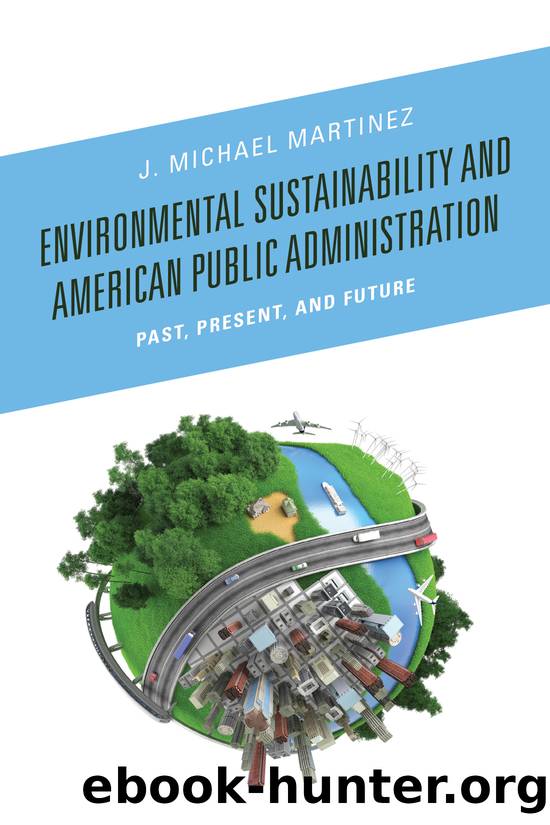Environmental Sustainability and American Public Administration by Martinez J. Michael;

Author:Martinez, J. Michael;
Language: eng
Format: epub
Publisher: Lexington Books/Fortress Academic
The Early Explorers
Perhaps an environmental movement was inevitable, or at least necessary, the day that two men set out on a journey to explore the interior lands of the United States in 1804. Meriwether Lewis and William Clark answered their presidentâs call to map out the acreage in the Louisiana Purchase and thereby assess its commercial and scientific possibilities. Their chief, Thomas Jefferson, possessed a restless mind; he had long been interested in determining whether a water route existed across the North American continent. To satisfy his curiosity and contribute to knowledge of the American landscape, he instructed his intrepid explorers to map out their route and collect specimens of plant and animal life along the way. The two-year Corps of Discovery Expedition succeeded beyond everyoneâs wildest imagination. Lewis and Clark passed into the annals of history as two of the greatest explorers of the nineteenth century. For his part, President Jefferson won accolades for his willingness to sponsor the celebrated venture that eventually opened up the American West to a fledgling nation and its people.2
The land was not completely pristine or unexplored. Aside from Native Americans, many of whom had journeyed through these lands for generations, even white Europeans had set foot on the continent in centuries past. During the sixteenth century, Spanish conquistadors traipsed through parts of the American South and into the Southwest. A hundred years later, French furriers tracked animals through many parts of what became the northern United States. Yet these explorations had been undertaken for many purposes, mostly commercial. Jeffersonâs Corps of Discovery Expedition was designed to gather systematic intelligence on the nationâs land mass.3
Lewis and Clark succeeded in exploring the interior lands and bringing back useful information and breathtaking specimens to President Jefferson. Yet they accomplished far more than they realized at the time. In mapping out the miles of forest land, rivers, streams, and byways of the continent, they fired the imaginations of generations of Americans. In the decades that followed the expedition, American settlers flocked to the West. It became a mythical place of enchantment, a place where a man might start over from scratch and build a new life from the sweat of his own brow. Many a restless soul agreed with Henry David Thoreau that a meaningful life could only be had in western lands. âEastward I go only by force; but westward I go free,â Thoreau wrote in his inimitable prose. âThither no business leads me. It is hard for me to believe that I shall find fair landscapes or sufficient wildness and freedom behind the eastern horizon. I am not excited by the prospect of a walk thither; but I believe that the forest which I see in the western horizon stretches uninterruptedly toward the setting sun, and there are no towns nor cities in it of enough consequence to disturb me. Let me live where I will, on this side is the city, on that the wilderness, and ever I am leaving the city more and more, and withdrawing into the wilderness.
Download
This site does not store any files on its server. We only index and link to content provided by other sites. Please contact the content providers to delete copyright contents if any and email us, we'll remove relevant links or contents immediately.
The Secret History by Donna Tartt(18152)
The Social Justice Warrior Handbook by Lisa De Pasquale(11950)
Thirteen Reasons Why by Jay Asher(8450)
This Is How You Lose Her by Junot Diaz(6431)
Weapons of Math Destruction by Cathy O'Neil(5825)
Zero to One by Peter Thiel(5487)
Beartown by Fredrik Backman(5349)
The Myth of the Strong Leader by Archie Brown(5236)
The Fire Next Time by James Baldwin(5015)
How Democracies Die by Steven Levitsky & Daniel Ziblatt(4950)
Promise Me, Dad by Joe Biden(4907)
Stone's Rules by Roger Stone(4852)
100 Deadly Skills by Clint Emerson(4686)
A Higher Loyalty: Truth, Lies, and Leadership by James Comey(4546)
Rise and Kill First by Ronen Bergman(4542)
Secrecy World by Jake Bernstein(4387)
The David Icke Guide to the Global Conspiracy (and how to end it) by David Icke(4376)
The Farm by Tom Rob Smith(4320)
The Doomsday Machine by Daniel Ellsberg(4242)
